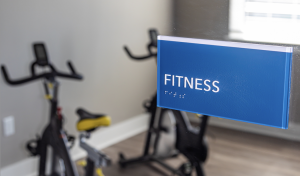Braille Signage
What Is a Braille Sign?
Braille signs are tactile signs that can be read by visually impaired or blind people. Braille itself is a system of raised dots that allow people with visual disabilities to read and write using their sense of touch.
Under the Americans with Disabilities Act (ADA), braille signage is required to mark all permanent spaces and rooms in public and commercial buildings in the U.S. Besides braille, ADA signs must also contain tactile characters that are raised from the surface.
Location of Permanent Room Identification Signs
Permanent room signs, such as restrooms and exits, have ADA guidelines on where they need to be located in relation to doorways:
- Permanent room signs are to be located at doorways; this gives the visually impaired a location cue.
- If only one door opens, the sign should mount to the inactive door.
- If the door swings outward, the sign needs to be mounted outside of the arc of the door swing.
What Are the Standards for Braille Signs?
In order to be compliant, the ADA has set the following regulations for braille signage:
- Written in contracted Grade 2 braille
- Shape – Braille dots shall have a domed or rounded shape
- Capitalization rules – Uppercase letter(s) shall only be used before the first word of sentences, proper nouns and names, individual letters of the alphabet, as well as initials and acronyms. Otherwise, everything should be in lowercase.
- Position – Braille shall be positioned below the corresponding text. If the text is multi-lined, braille shall be placed below the entire text.
- Separation – Braille shall be separated ⅜ inch minimum from any other tactile characters and ⅜ inch minimum from raised borders and decorative elements.
- For elevator car controls, on the other hand, the braille shall be separated 3/16 inch (4.8 mm) minimum and shall be located either directly below or adjacent to the corresponding raised characters or symbols.
- In general, all ADA signs should have a non-glare finish and high contrast between the text and the background.
- Pictograms are optional
How High Should Braille Signs Be Mounted?
According to the ADA, tactile characters on signs shall be located 48 inches minimum above the finish floor or ground surface, measured from the baseline of the lowest tactile character and 60 inches maximum above the finish floor or ground surface, measured from the baseline of the highest tactile character.
Where Should Braille Signs Be Mounted?
By ADA standards, where a tactile sign is provided at a door, the sign shall be located alongside the door at the latch side. So, always on the side where the handle is. If there is no room on the side where the handle is, the sign can be mounted on the nearest adjacent wall.
Other ADA Braille Sign Requirements
For the visually impaired, there are certain tactile requirements your signs must comply with that include:
- Stroke thickness must be between 10% to 30% of the height of the uppercase “I”
- Character spacing needs to be between 10% to 35% of the character height
- Line spacing between the baselines of separate lines of copy should be between 135% to 170% of the maximum character height
Braille Signage Experts
As the leading signage experts in the Southeast, we would be happy to provide you with solutions to your braille signage needs. Give us a call at 919-789-1452 or contact us here today to get a free quote.

